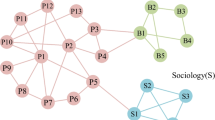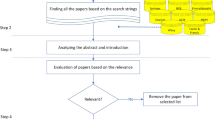Abstract
Identifying the dense subgraphs from large graphs is important and useful to various social media mining applications. Most of existing works focus on the densest subgraph problem in the unweighted and undirected represented social network which can maximize the average degree over all possible subgraphs. However, considering the frequent signed relationships occurred in real-life social network, this paper introduces the social-balanced densest subgraph problem in signed social network by incorporating the social balance theory. We obtain a novel problem formulation that is to identify the subset of vertices that can maximize the social-balanced density in signed social networks. Further, we propose an efficient approach for identifying the social-balanced densest subgraph based on formal concept analysis. The case study illustrates that our algorithm can efficiently identify the social-balanced densest subgraph for satisfying the specific application’s requirements.








Similar content being viewed by others
Notes
It indicates that the number of vertices in the subgraph.
References
Tsourakakis C, Bonchi F, Gionis A, Gullo F, Tsiarli M (2013) Denser than the densest subgraph: extracting optimal quasi-cliques with quality guarantees. In: Proceedings of the 19th ACM SIGKDD international conference on knowledge discovery and data mining, pp 104–112
Gibson D, Kumar R, Tomkins A (2005) Discovering large dense subgraphs in massive graphs. In: Proceedings of the 31st international conference on very large data bases, pp 721–732
Li M, Chen W, Wang J, Wu FX, Pan Y (2014) Identifying dynamic protein complexes based on gene expression profiles and PPI networks. BioMed research international
Du X, Jin R, Ding L, Lee VE, Thornton Jr JH (2009) Migration motif: a spatial-temporal pattern mining approach for financial markets. In: Proceedings of the 15th ACM SIGKDD international conference on knowledge discovery and data mining, pp 1135–1144
Khuller S, Saha B (2009) On finding dense subgraphs, automata, languages and programming. Springer, Berlin Heidelberg
Tsourakakis CE (2015) The k-clique densest subgraph problem. In: Proceedings of the 24th international conference on world wide web, pp 1122–1132
Doreian P, Mrvar A (2009) Partitioning signed social networks. Soc Netw 31(1):1–11
Yang S, Smola AJ, Long B, Zha H, Chang Y (2012) Friend or frenemy? Predicting signed ties in social networks. In: Proceedings of the 35th international ACM SIGIR conference on research and development in information retrieval, pp 555–564
Yang B, Cheung WK, Liu J (2007) Community mining from signed social networks. IEEE Trans Knowl Data Eng 19(10):1333–1348
Scott JP (2000) Social network analysis: a handbook, 2nd edn. Sage Publications Ltd., Thousand Oaks
Flake GW, Lawrence S, Giles CL (2000) Efficient identification of web communities. In: Proceeding of KDD00: proceedings of the 6th ACM SIGKDD international conference on knowledge discovery and data mining, pp 150–160
Nagurney Anna (ed) (2004) Innovations in financial and economic networks (New Dimensions in Networks). Edward Elgar Publishing, Cheltenham
Lee D (2015) Personalizing information using users online social networks: a case study of CiteULike. J Inf Process Syst 11(1):1–21
Rafiei M, Kardan AA (2015) A novel method for expert finding in online communities based on concept map and PageRank. In: Human-centric computing and information sciences, pp 5–10
Junker BH, Schreiber F (2008) Analysis of biological networks. Wiley, New York
Leskovec J, Huttenlocher D, Kleinberg J (2010) Signed networks in social media. In: Proceedings of SIGCHI conference on human factors in computing systems, pp 1361–1370
Traag VA, Bruggeman J (2009) Community detection in networks with positive and negative links. Phys Rev E 80(3):1–6
Hao F, Yau SS, Min G, Yang LT (2014) Detecting k-balanced trusted cliques in signed social networks. IEEE Internet Comput 18(2):24–31
Cartwright D, Harary F (1956) Structure balance: “A generalization of heiders theory”. Psychol Rev 63(5):277–293
Ghosn F, Palmer G, Bremer S (2004) The MID3 data set, 1993–001: procedures, coding rules, and description. Confl Manag Peace Sci 21(2):133–154
Gibler DM, Sarkees M (2004) Measuring alliances: the correlates of war formal interstate alliance dataset, 1816–2000. J Peace Res 41(2):211–222
Hao F, Min G, Pei Z, Park DS, Yang LT (2015) k-clique communities detection in social networks based on formal concept analysis. IEEE Syst J. doi:10.1109/JSYST.2015.2433294
Kim KR, Moon N (2014) Content modeling based on social network community activity. J Inf Process Syst 10(2):271–282
Wu M, Li XL, Kwoh CK (2008) Algorithms for detecting protein complexes in PPI networks: an evaluation study. In: Proceedings of third IAPR international conference on pattern recognition in bioinformatics (PRIB 2008), pp 15–17
Gregori E, Lenzini L, Mainardi S (2013) Parallel \(k\)-clique community detection on large-scale networks. IEEE Trans Parallel DistribSyst 24(8):1651–1660
Acknowledgments
This research was supported by the MSIP (Ministry of Science, ICT and Future Planning), Korea, under the C-ITRC (Convergence Information Technology Research Center) (IITP-2015-IITP-2015-H8601-15-1009) supervised by the IITP (Institute for Information and communications Technology Promotion) and was partly supported by the Natural Science Foundation for Young Scientists of Shanxi Province, China (Grant No. 2015021102) and Z. Pei’s work is partially supported by National Nature Science Foundation of China (Grant No. 61372187).
Author information
Authors and Affiliations
Corresponding author
Rights and permissions
About this article
Cite this article
Hao, F., Park, DS., Pei, Z. et al. Identifying the social-balanced densest subgraph from signed social networks. J Supercomput 72, 2782–2795 (2016). https://doi.org/10.1007/s11227-015-1606-6
Published:
Issue Date:
DOI: https://doi.org/10.1007/s11227-015-1606-6




